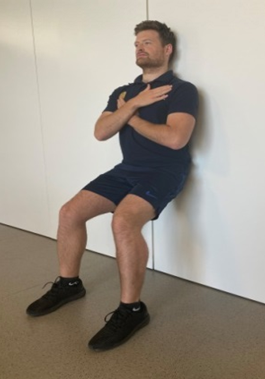Neurodiversity information for parents and young people
Here we give basic information on patellar tendinopathy and how it is treated. Your physiotherapist may give you additional information to address your specific needs.
![]()
About the patellar tendon
The patellar tendon is a continuation of the thigh muscles (quadriceps) at the front of your thigh. It attaches the muscles and kneecap (patella) to the top of your shin bone (tibia).

Common symptoms
The common symptoms are:
- pain over patellar tendon
- gradual increase in pain
- pain and/or stiffness after rest
- pain after strenuous activity, such as running or jumping
- the affected tendon may seem thickened compared to the unaffected side.
Causes
The tendon is injured when it cannot cope with the strain on it. Common reasons for this are:
- high volumes of weight bearing exercise, such as running or jumping
- sudden increase in activity or training volume
- being overweight or unfit
- weak knee or hip muscles
- reduced ankle movement.
What you can do
Simple steps can help reduce the strain on your knee.
- Rest – your physiotherapist will tell you how long for.
- Stop or reduce higher impact activities, such as running or jumping.
- Try to lose weight if you are overweight. This will help reduce the strain on the tendon.
- Do gradual strengthening exercises to improve the condition of the tendon – see below.
Strengthening exercises
Because the pain is caused by the tendon not coping with the weight or ‘load’ being put on it, strengthening exercises are recommended.
Your physiotherapist will tell you how long to rest for before you start the exercises.
The exercises are phased. This means that you gradually build up as you get stronger.
Your physiotherapist will tell you when and how to start the exercises, and may also adapt them for your needs. Do not continue them if they significantly increase your pain.
You can move on to each new phase when you feel ready. This is usually if the pain or discomfort is settling within 24 hours.
Phase 1:
Straightening knee against band
These exercises involve holding a position.
- Sit in a supportive chair.
- Loop a resistance band around the leg of the chair and the front of the foot of your affected leg.
- Straighten your knee against the resistance of the band. Hold for 15 to 45 seconds.
- Repeat this 3 to 5 times.
- Repeat 3 times a day.

Phase 2: Double leg wall sit
- Stand with your back against a wall and your feet in front of you.
- Slide down the wall (to a level you can manage) and hold a seated position for 15 to 45 seconds.
- Repeat this 3 to 5 times.
- Repeat 3 times a day.

Phase 3: single leg wall sit
-
Stand with your back against a wall and your feet in front of you. Put your ‘good’ leg further forwards so more weight is on your injured side.
-
Slide down the wall and hold a seated position for 15 to 45 seconds.
-
Repeat this 3 to 5 times.
-
Repeat 3 times a day.

Phase 4: squatting
- Stand in front of a chair with feet hip width apart.
- Squat down by sitting your hips back, as though going to sit down.
- Push back up into standing.
- Repeat 8 to 15 times.
- Repeat this 3 times, with a 1 minute rest between each set.
- Do once a day.

Phase 5: single leg squatting
- Stand in front of a chair with feet hip width apart.
- Put your ‘good’ leg further forwards so more weight is on your injured side.
- Squat down by sitting your hips back, as though going to sit down.
- Push back up into standing.
- Repeat 8 to 15 times.
- Repeat this 3 times, with a 1 minute rest between each set.
- Do once a day.

Contact information
Physiotherapy